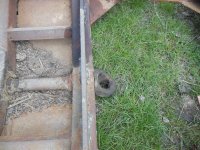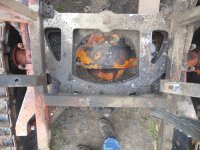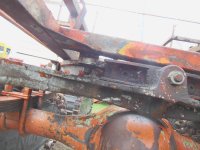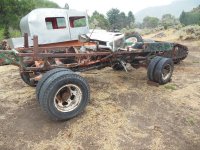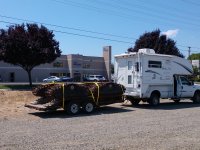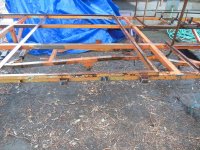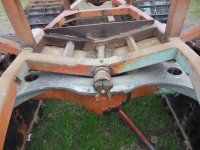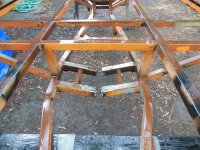I have recently purchased a well used and poorly maintained 1966 Tucker 542 Cab Forward Sno Cat. I am restoring this unit with my two sons and would appreciate help along the way, since I basically know nothing about Tuckers. I will try to record this restoration on this thread as we move along. As many of you know I recently completed restoration of a Frandee Model D, which took me nearly 8 years. This 542CF should not take as long, however it will take at least a couple of years.
So how did I find it? Well I didn't. I went to my first snowcat gathering in McCall, Idaho this last February for the Frandee's maiden snow voyage. By the way, I had a great time. Anyway, before that I had met the son (Scott Eskelson) of the design engineer (Ross Eskelson) for my Frandee a few weeks prior. At that time I also got the contact information for his sister, (Doreen) who happens to live in Mountain Home, Idaho. Well Mountain Home is between Pocatello, Idaho where I live and McCall. So I set up a meeting with Doreen and we met at a gas station as I was headed to McCall. On the way back home from McCall I stopped at her house and it had just snowed so we off loaded the Frandee and she and her whole family got to ride and drive in the snowcat. She was elated, it brought back memories of her dad. After the rides we were invited for dinner and after that I was shown many photos from her fathers snowcat designing years. I was talking to her husband, Ted, who told me he had seen a Tucker down the road. When the Frandee was built he told me that Ross had competed with the Tuckers, in hill climbs and such. Well I wasn't really interested in a Tucker, my friend Shawn has one for sale, and I could have bought it, it runs and is in turn key condition. So we headed home late that night and never went to see it. Then after some time my curiosity rose and I contacted Ted and he showed me where it was. I was able to look at in on google earth, it was literally 20 feet off the road. So, then a few weeks later I had to go to the Tri-cities in Washington and would be driving by Mountain Home again, so I stopped to take a look at it in person. At that point I attempted to find out who the owner was with no luck. I took some pictures and sent a couple to the new friend I had made at McCall, mikemikelle (forum name). Well while I was on my trip to Washington Mike was able to figure out where the cat was (I had not told him, he used his advanced detective skills). He also was able to help me determine what the value might be (he apparently has some secret contacts that he would not divulge). He also contacted the Tucker factory and was able to get a build sheet for this unit. We decided to partner up and see if we could locate the owner and possibly purchase the unit. Not quite sure why, we both have snowcats already and really hadn't ever considered owning a Tucker. I think it was the challenge of the hunt and actually bagging the game (we are both hunters). So with the information he had obtained we decided on a price that the unit was worth. On the way home from Washington I stopped at the cat again and tried to find the owner once again, no luck. I had just gotten back onto the interstate to head home and Mike calls me, he has located the owners and has their phone number (I cannot tell you how far my jaw dropped, I still had not told him it's location or any details, this guy is amazing at his detective skills). So I turned around and made some stops and called some people and left many messages. The next day I received a call from the owner, he gave me his price, which was higher than what Mike and I had discussed, but he was extremely firm on the price and he let me know it. He had done some research and determined what he thought the value was. Well I thought about it and decided to buy, 12 hours later it was sitting in my yard on a trailer. So, now what do we do with it. It took me 8 years to restore the last one, I am retiring in a couple of years and have promised to build my wife a house at that time. I decided that it would be 4 or 5 years before I would even get a chance to work on this snowcat. So, I decided to see if anyone might want to buy it, since Mike did not want it. Mike was given the go ahead to see if he knew anyone that might be interested. Then, the next day I had a change of mind, Mike did make a derogatory remark about my mind changing, but our friendship survived the dig and I paid him for his interest in the snowcat. Why keep, well I have two sons and they both wanted me to keep it so they could learn how to restore a snowcat, they did not participate much in the Frandee restoration. I found that this cab forward was somewhat rare and I like the rare factor (just like my Frandee). From the Tucker build sheets it appears that the Boy Scouts of America may have owned or had an interest in this unit at one time (both of my boys are Eagle scouts). And mostly, it just has a cool factor, I love the flat bed and the look of the cab, plus it has this cool Jeep Tornado 230 overhead cam "hemi" engine from 1965ish. So that is the story, my son has already mostly dismantled the unit and restoration is in progress. I will show the restoration back to day one as I get time, just be patient.
So how did I find it? Well I didn't. I went to my first snowcat gathering in McCall, Idaho this last February for the Frandee's maiden snow voyage. By the way, I had a great time. Anyway, before that I had met the son (Scott Eskelson) of the design engineer (Ross Eskelson) for my Frandee a few weeks prior. At that time I also got the contact information for his sister, (Doreen) who happens to live in Mountain Home, Idaho. Well Mountain Home is between Pocatello, Idaho where I live and McCall. So I set up a meeting with Doreen and we met at a gas station as I was headed to McCall. On the way back home from McCall I stopped at her house and it had just snowed so we off loaded the Frandee and she and her whole family got to ride and drive in the snowcat. She was elated, it brought back memories of her dad. After the rides we were invited for dinner and after that I was shown many photos from her fathers snowcat designing years. I was talking to her husband, Ted, who told me he had seen a Tucker down the road. When the Frandee was built he told me that Ross had competed with the Tuckers, in hill climbs and such. Well I wasn't really interested in a Tucker, my friend Shawn has one for sale, and I could have bought it, it runs and is in turn key condition. So we headed home late that night and never went to see it. Then after some time my curiosity rose and I contacted Ted and he showed me where it was. I was able to look at in on google earth, it was literally 20 feet off the road. So, then a few weeks later I had to go to the Tri-cities in Washington and would be driving by Mountain Home again, so I stopped to take a look at it in person. At that point I attempted to find out who the owner was with no luck. I took some pictures and sent a couple to the new friend I had made at McCall, mikemikelle (forum name). Well while I was on my trip to Washington Mike was able to figure out where the cat was (I had not told him, he used his advanced detective skills). He also was able to help me determine what the value might be (he apparently has some secret contacts that he would not divulge). He also contacted the Tucker factory and was able to get a build sheet for this unit. We decided to partner up and see if we could locate the owner and possibly purchase the unit. Not quite sure why, we both have snowcats already and really hadn't ever considered owning a Tucker. I think it was the challenge of the hunt and actually bagging the game (we are both hunters). So with the information he had obtained we decided on a price that the unit was worth. On the way home from Washington I stopped at the cat again and tried to find the owner once again, no luck. I had just gotten back onto the interstate to head home and Mike calls me, he has located the owners and has their phone number (I cannot tell you how far my jaw dropped, I still had not told him it's location or any details, this guy is amazing at his detective skills). So I turned around and made some stops and called some people and left many messages. The next day I received a call from the owner, he gave me his price, which was higher than what Mike and I had discussed, but he was extremely firm on the price and he let me know it. He had done some research and determined what he thought the value was. Well I thought about it and decided to buy, 12 hours later it was sitting in my yard on a trailer. So, now what do we do with it. It took me 8 years to restore the last one, I am retiring in a couple of years and have promised to build my wife a house at that time. I decided that it would be 4 or 5 years before I would even get a chance to work on this snowcat. So, I decided to see if anyone might want to buy it, since Mike did not want it. Mike was given the go ahead to see if he knew anyone that might be interested. Then, the next day I had a change of mind, Mike did make a derogatory remark about my mind changing, but our friendship survived the dig and I paid him for his interest in the snowcat. Why keep, well I have two sons and they both wanted me to keep it so they could learn how to restore a snowcat, they did not participate much in the Frandee restoration. I found that this cab forward was somewhat rare and I like the rare factor (just like my Frandee). From the Tucker build sheets it appears that the Boy Scouts of America may have owned or had an interest in this unit at one time (both of my boys are Eagle scouts). And mostly, it just has a cool factor, I love the flat bed and the look of the cab, plus it has this cool Jeep Tornado 230 overhead cam "hemi" engine from 1965ish. So that is the story, my son has already mostly dismantled the unit and restoration is in progress. I will show the restoration back to day one as I get time, just be patient.
Attachments
Last edited:


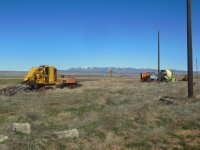
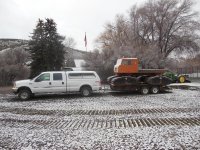
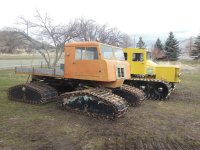
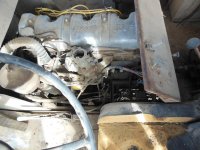

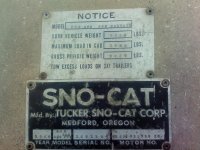


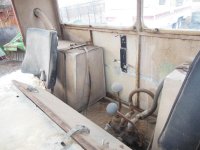
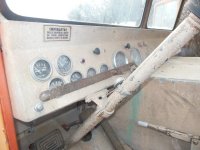
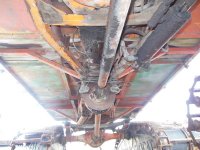
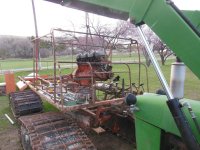
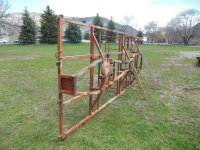
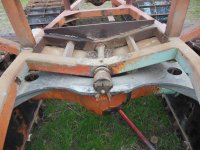
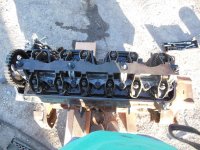
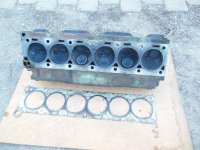
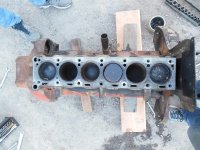
 ... but the gas card your Frandee earned for McCallin’ 2018 could be picked up at LSH in February for your new Tucker 542ASC.
... but the gas card your Frandee earned for McCallin’ 2018 could be picked up at LSH in February for your new Tucker 542ASC.
